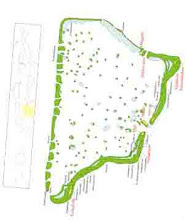 Ljubljana, the capital of Slovenia, is a central European city lying between the Alps and the Adriatic Sea, in a basin where the Ljubljanica River flows into the Sava. Ljubljana as a city made to the measure of man. It is classified as a mid-sized European city, but it has preserved its small-town friendliness and relaxed atmosphere while providing all the facilities of a modern capital, and a very unique city dotted with pleasant picturesque places where you can expect all kinds of nice little surprises. During winter, its dreamy central European character prevails, and during summer its relaxed Mediterranean feel. Due to its geographical position, Ljubljana is also a perfect base for exploring the many faces and beauties of Slovenia, specially the natural beauty and cultural. Ljubljana's present appearance is partly due to the Italian Baroque and partly to Art Nouveau, which found expression in numerous buildings constructed after the earthquake of 1895. In the second half of the 20th century, it was the world famous architect Jože Plečnik that put an indelible personal stamp on his native Ljubljana. The city's appearance was further shaped by his students and a new wave of renowned young Slovenian architects. One of my favorite’s buildings is the well preserved Cooperative Business Bank building, located in the Miklošičeva Ulica Street. It is one of Ljubljana's most famous buildings. Despite being situated in a brightly coloured Art Nouveau quarter, its richly decorated facade makes it stand out from the surrounding buildings. Built in 1921 to a design by the architect Ivan Vurnik, it is considered to be one of the finest examples of Slovenian national style architecture. The inside of the building boasts a large reception hall with wall paintings and a glass ceiling constructed from small blue squares of glass with an inbuilt decorative strip made from various coloured bottles. The staircase hall on the first and second floors is decorated with stained glass windows depicting geometric motifs. The building's facade frescoes and interior wall paintings are the work of the architect Vurnik's Viennese-born wife Helena, who had taken part in her husband's research and design of distinctive Slovenian architecture. Her geometric ornaments in red, white and blue, the colour combination of the Slovenian tricolour, are mixed with elements of Slovenian iconography, such as stylized spruce-wooded and cornfield landscapes, vine plants and women in Slovenian national costumes.
Ljubljana, the capital of Slovenia, is a central European city lying between the Alps and the Adriatic Sea, in a basin where the Ljubljanica River flows into the Sava. Ljubljana as a city made to the measure of man. It is classified as a mid-sized European city, but it has preserved its small-town friendliness and relaxed atmosphere while providing all the facilities of a modern capital, and a very unique city dotted with pleasant picturesque places where you can expect all kinds of nice little surprises. During winter, its dreamy central European character prevails, and during summer its relaxed Mediterranean feel. Due to its geographical position, Ljubljana is also a perfect base for exploring the many faces and beauties of Slovenia, specially the natural beauty and cultural. Ljubljana's present appearance is partly due to the Italian Baroque and partly to Art Nouveau, which found expression in numerous buildings constructed after the earthquake of 1895. In the second half of the 20th century, it was the world famous architect Jože Plečnik that put an indelible personal stamp on his native Ljubljana. The city's appearance was further shaped by his students and a new wave of renowned young Slovenian architects. One of my favorite’s buildings is the well preserved Cooperative Business Bank building, located in the Miklošičeva Ulica Street. It is one of Ljubljana's most famous buildings. Despite being situated in a brightly coloured Art Nouveau quarter, its richly decorated facade makes it stand out from the surrounding buildings. Built in 1921 to a design by the architect Ivan Vurnik, it is considered to be one of the finest examples of Slovenian national style architecture. The inside of the building boasts a large reception hall with wall paintings and a glass ceiling constructed from small blue squares of glass with an inbuilt decorative strip made from various coloured bottles. The staircase hall on the first and second floors is decorated with stained glass windows depicting geometric motifs. The building's facade frescoes and interior wall paintings are the work of the architect Vurnik's Viennese-born wife Helena, who had taken part in her husband's research and design of distinctive Slovenian architecture. Her geometric ornaments in red, white and blue, the colour combination of the Slovenian tricolour, are mixed with elements of Slovenian iconography, such as stylized spruce-wooded and cornfield landscapes, vine plants and women in Slovenian national costumes.
Ponto de partida e de chegada. Lisboa
-
Às vezes tento ler o meu futuro. Não nos astros, nem nas cartas, nem na
palma da mão. Tento lê-lo dentro de mim. Mas encontro tantas páginas soltas
que nã...
















1 comentário:
já sentia a tua falta.
F.
Enviar um comentário